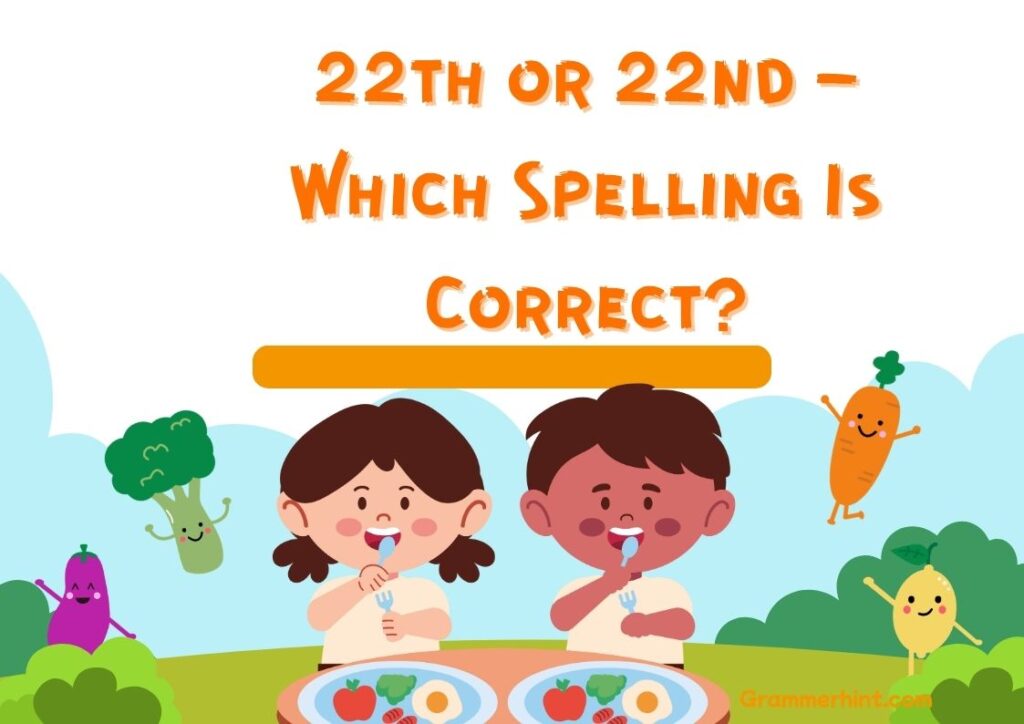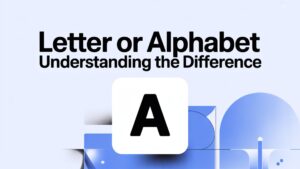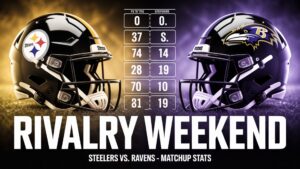When writing or speaking English, ordinal numbers can be confusing. One question that often pops up is: “22th or 22nd – which spelling is correct?”
If you’ve ever written a date like April 22th or May 22th, you might want to keep reading. This article will clarify everything about the ordinal form of 22, explain why ’22nd’ is correct, and help you avoid common grammar mistakes involving numbers.
22th or 22nd – Which Spelling Is Correct?

The correct spelling of the ordinal number for 22 is 22nd. The form 22th is an incorrect form and should be avoided in all formal and informal writing.
So to be clear:
- 22nd (correct ordinal form) ✅
- 22th (incorrect form) ❌
Why is this the case? Let’s look at how ordinal numbers in English work.
22th
The spelling “22th” might look like it makes sense because the number 22 ends in 2. But in English, ordinal numbers have specific suffixes that follow well-established rules.
Is 22th correct?
No. According to the grammar rules for ordinal numbers, the correct suffix for numbers ending in 2 (except 12) is “nd”. So 22th is a misspelling and an example of one of the most common suffix errors in numbers.
Let’s take a look at a scenario where someone uses this incorrect form:
Incorrect Email Example:
Hi Annie,
Just a reminder that our next meeting is on May 22th. Please prepare your slides by then.
Best, Danny
This sentence contains a spelling mistake. “22th” is grammatically incorrect. Let’s see how to fix it.
Corrected Email:
Hi Annie,
Just a reminder that our next meeting is on May 22nd. Please prepare your slides by then.
Best, Danny
22nd
22nd is the proper ordinal number usage for 22. It follows the standard English ordinal rules. The number 22 ends in the digit 2, and that takes the “nd” suffix, like 2nd, 22nd, 32nd, and 42nd.
This is how suffix for 22 works:
- 1 → 1st (first)
- 2 → 2nd (second)
- 3 → 3rd (third)
- All other digits generally take “th”, except for some irregular ordinal numbers.
Ordinal form of 22: Twenty-second
22 (cardinal form of ordinal number): 22
Written form: Twenty-Second
Examples of the correct form in real-life situations:
Correct Email Example:
Hi Wendy,
Your final submission is due on February 22nd. Make sure to double-check the formatting.
Thanks, Maria
Here are more date examples using the correct ordinal for 22:
- April 22nd
- September 22nd
- October 22nd
Which Is Used the Most?
Let’s look at some tools to see usage frequency.
1. Google Ngram Viewer
When you compare “22nd” and “22th” using Google Ngram Viewer, you’ll find that “22nd” dominates in usage, while “22th” barely appears. This shows that real-world English usage overwhelmingly supports the correct form.
2. Cambridge Dictionary and Merriam-Webster Dictionary
Both authoritative sources confirm that 22nd is correct. You won’t find “22th” listed as a proper form in either dictionary.
Grammar Rule for Ordinal Numbers
Here’s a quick ordinal suffix guide for numbers ending in different digits:
| Ending Digit | Ordinal Suffix | Example |
|---|---|---|
| 1 | st | 21st |
| 2 | nd | 22nd |
| 3 | rd | 23rd |
| 4-0 | th | 24th, 30th |
Note: Numbers ending in 11, 12, and 13 are exceptions (e.g., 11th, 12th, 13th).
So, while 2nd and 22nd use “nd,” 12th uses “th” because it’s an irregular ordinal.
This rule helps answer the question: nd or th for 22? Definitely nd.
Date Formatting and Hyphenation
When writing dates:
- It’s grammatically correct to use 22nd in both formal and casual writing.
- In most cases, hyphenation isn’t required when using numeric ordinals.
For example:
- Correct: He was born on September 22nd.
- Incorrect: He was born on September 22-th.
When writing out the number in words:
- Correct: Twenty-second
- Incorrect: Twenty-secondth
Common Spelling Mistakes with Numbers
Here are some examples of ordinal number errors people commonly make:
| Incorrect Form | Correct Form | Explanation |
| 22th | 22nd | 22 ends in 2, so it takes “nd” |
| 23th | 23rd | 23 ends in 3, so it takes “rd” |
| 32th | 32nd | 32 ends in 2, use “nd” not “th” |
| 42th | 42nd | 42 ends in 2, use “nd” |
These are all common grammar mistakes. If you’re ever unsure, refer to the Merriam-Webster Dictionary or the Cambridge Dictionary.
Proper Use of Suffixes
English number suffix rules follow logic, but exceptions do exist. Here’s how to keep it straight:
- Always check the last digit of the number.
- Use “st” for 1 (except 11), “nd” for 2 (except 12), “rd” for 3 (except 13), and “th” for everything else.
Examples:
- 2 → 2nd
- 22 → 22nd
- 32 → 32nd
- 42 → 42nd
This is the English suffix usage system that governs writing numbers correctly.
Spelling Ordinal Numbers in Writing
If you’re spelling out numbers instead of using digits, here’s how:
- Correct written form: Twenty-second
- Incorrect written form: Twenty-secondth
So, the answer to “How to write 22 in ordinal form?” is:
- Numerically: 22nd
- In words: Twenty-second
This aligns with the word formation of ordinal numbers in standard English.
Final Thoughts
So, back to our original question: 22th or 22nd – which spelling is correct? The answer is 100% clear. 22nd is the correct form based on established grammar for numbers and English ordinal rules.
Let’s recap:
- Avoid 22th at all costs
- Use 22nd in all forms of communication
- Remember the ordinal number spelling in writing: Twenty-second
- Double-check your dates: May 22nd, April 22nd, October 22nd
Whether you’re writing a birthday card, a business email, or filling out a form, getting the suffix for 22 right matters.
Understanding the difference between 22th and 22nd helps you stay clear of embarrassing errors and showcases your command of grammatical correctness in English.
Next time someone asks about English ordinal numbers, you’ll know exactly what to say.









